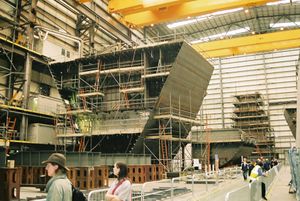بناء السفن

بناء السفن Shipbuilding، هو إنشاء السفن والمركبات العائمة الأخرى. عادة ما يحدث هذا في مرفق متخصص يُعرف بحوض بناء السفن. بناؤو السفن، هم ممارسو المهنة التي ترجع بجذورها إلى ما قبل التاريخ المسجل.
علم بناء وإصلاح السفن، سواء التجارية أو العسكرية، يُعرف باسم "الهندسة البحرية". إنشاء الزواق هو نشاط مشابه يسمى بناء الزوارق.
أما تكسير السفن فيسمى تفكيك السفن.
التاريخ
ما قبل التاريخ
تشير الأدلة الأثرية إلى أن البشر وصلوا إلى غينيا الجديدة ما لا يقل عن 60000 سنة مضت، ربما عن طريق البحر من جنوب شرق آسيا خلال فترة العصر الجليدي عندما كان البحر أقل وأقصر المسافات بين الجزر (أنظر تاريخ بابوا غينيا الجديدة). أسلاف سكان أستراليا الأصليين وغينيا الجديدة ذهبوا عبر مضيق لومبوك بالقوارب أكثر من 50000 سنة مضت.
الألفية الرابعة ق.م.
الألفية الثالثة ق.م.
الألفية الثالثة ق.م.
الألفية الثانية ق.م.
الألفية الأولى ق.م.
أوائل الألفية الأولى
أوروپا في العصور الوسطى، سونگ الصين، الخلافة العباسية، جزر المحيط الهادئ، مينگ الصين

مينگ الصين
أوائل مينگ (1368-1476)
أواخر مينگ (1478-1644)
بداية العصر
ثورة صناعية

صناعة بناء السفن في جميع أنحاء العالم

بناء السفن في الوقت الحاضر
| صناعة السفن العالمية | ||||
| الترتيب | البلد | الحمولة الإجمالية في 2018، 000s[1] | Market Share by New Orders in 2018[2] | |
|---|---|---|---|---|
| 1 | 49,600 | 40% | ||
| 2 | 43,900 | 36% | ||
| 3 | 13,005 | 7% | ||
| 4 | Others | 5,000 | 17% | |
تقنيات تصنيع السفن الحديثة
Modern shipbuilding makes considerable use of prefabricated sections. Entire multi-deck segments of the hull or superstructure will be built elsewhere in the yard, transported to the building dock or slipway, then lifted into place. This is known as "block construction". The most modern shipyards pre-install equipment, pipes, electrical cables, and any other components within the blocks, to minimize the effort needed to assemble or install components deep within the hull once it is welded together.
Ship design work, also called naval architecture, may be conducted using a ship model basin. Previously, loftsmen at the mould lofts of shipyards were responsible for taking the dimensions, and details from drawings and plans and translating this information into templates, battens, ordinates, cutting sketches, profiles, margins and other data.[3] However, since the early 1970s computer-aided design (CAD) became normal for the shipbuilding design and lofting process.[4]
Modern ships, since roughly 1940, have been produced almost exclusively of welded steel. Early welded steel ships used steels with inadequate fracture toughness, which resulted in some ships suffering catastrophic brittle fracture structural cracks (see problems of the Liberty ship). Since roughly 1950, specialized steels such as ABS Steels with good properties for ship construction have been used. Although it is commonly accepted that modern steel has eliminated brittle fracture in ships, some controversy still exists.[5] Brittle fracture of modern vessels continues to occur from time to time because grade A and grade B steel of unknown toughness or fracture appearance transition temperature (FATT) in ships' side shells can be less than adequate for all ambient conditions.[6]
صناعة إصلاح السفن
All ships need repair work at some point in their working lives. A part of these jobs must be carried out under the supervision of the classification society.
A lot of maintenance is carried out while at sea or in port by ship's crew. However a large number of repair and maintenance works can only be carried out while the ship is out of commercial operation, in a ship repair yard.
Prior to undergoing repairs, a tanker must dock at a deballasting station for completing the tank cleaning operations and pumping ashore its slops (dirty cleaning water and hydrocarbon residues).
أنظر أيضا
- قائمة شركات بناء السفن وأحواض بناء السفن
- قائمة أكبر شركات بناء السفن
- قائمة شركات بناء السفن الروسية
- Marine propulsion
- بناء السفن في المستعمرات الأمريكية
المصادر
- ^ "Largest shipbuilding nations based on gross tonnage 2018 - Ranking". Statista.
- ^ "Global shipbuilding market by region: contracting 2018 - Statistic". Statista.
- ^ Loftsman, The. "The Mould Loft". Archived from the original on 28 July 2016. Retrieved 19 July 2016.
{{cite web}}: Unknown parameter|deadurl=ignored (|url-status=suggested) (help) - ^ Loftsman, The. "CAD-Computer Aided Design". Archived from the original on 2 August 2016. Retrieved 19 July 2016.
{{cite web}}: Unknown parameter|deadurl=ignored (|url-status=suggested) (help) - ^ Drouin, P: "Brittle Fracture in ships – a lingering problem", page 229. Ships and Offshore Structures, Woodhead Publishing, 2006.
- ^ "Marine Investigation Report – Hull Fracture Bulk Carrier Lake Carling". Transportation Safety Board of Canada. 19 March 2002. Archived from the original on 15 October 2012. Retrieved 8 October 2009.
{{cite web}}: Unknown parameter|deadurl=ignored (|url-status=suggested) (help)
الهوامش
- Tripathi, Rama Shankar (1967). History of Ancient India. Motilal Banarsidass. p. 145. ISBN 81-208-0018-4.
- Hourani, George Fadlo; Carswel, John (1995). Arab Seafaring: In the Indian Ocean in Ancient and Early Medieval Times. Princeton University Press. p. 90. ISBN 0-691-00032-8.
وصلات خارجية
- Shipbuilding Picture Dictionary
- U.S. Shipbuilding—extensive information about the U.S. shipbuilding industry, including over 500 pages of U.S. shipyard construction records
- Shipyards United States—from GlobalSecurity.org
- Shipbuilding News
- Bataviawerf – the Historic Dutch East Indiaman Ship Yard—Shipyard of the historic ships Batavia and Zeven Provincien in the Netherlands, since 1985 here have been great ships reconstructed using old construction methods.
- Photos of the reconstruction of the Dutch East Indiaman Batavia—Photo web site about the reconstruction of the Batavia on the shipyard Batavia werf, a 16th-century East Indiaman in the Netherlands. The site is constantly expanding with more historic images as in 2010 the shipyard celebrates its 25th year.




